Secure and Lightweight Authentication Protocol for Privacy Preserving Communications in Smart City Applications
Abstract
1. Introduction
- An authentication protocol and critical exchange for smart cities is presented, and all the possible attacks and challenges are discussed in the paper;
- A proposed authentication protocol is analyzed with the help of Burrows–Abadi–Needham logic (BAN) to show the protocol is proficient and secure;
- The proposed protocol’s cryptographic computational cost and energy consumption are calculated to determine the protocol’s effectiveness;
- A proposed authentication protocol is simulated using automation validation of the internet security protocol and application (AVISPA) tool to verify the security;
- A proposed authentication protocol is compared with other related work, and the effectiveness in terms of minimization of different types of attacks is demonstrated.
2. Literature Review
3. Methodology
- Setup phase (Gateway);
- Registration phase (User);
- Sensor registration phase;
- Login phase (User);
- Authentication and key exchange phase (User);
- Update phase (Password);
- Revocation phase.
3.1. Gateway Setup Phase:
| e*d = 1 mod n |
| d = e − 1 mod n |
3.2. Sensor Registration Phase:
| RSi = h (ISi || di) |
3.3. User Registration Phase:
| PUj = H (IUj || Rj). |
| Mi = H (PUj || d), |
| APUj = H (PUj || Rj). |
| Aj = M1 ⊕ H (APUj || IUj) |
| Bj = H (IUj ⊕ APUj) |
| Cj = Rj ⊕ H (IUj || PUj). |
3.4. User Login Phase:
| Rj′ = Cj ⊕ H (IUj || PUj) |
| PUj′ = H (IUj || Rj′) |
| APUj = H (PUj || Rj′) |
| Bj = H (IUj ⊕ APUj′) |
| Mj′ = Aj ⊕ H (APUj′ || IUj). |
| Dj = H (APUj′ || Rs || M1′ || T1) |
| Ej = H (PUj′ || APUj′ || Mj′) ⊕ Rs |
| Fj = H (PUj′ || APUj′ || Rs || M1′ || T1) a mod b. |
3.5. User Authentication and Key Exchange Phase
| D = (Fj) mod b = (PUj′, APUj′, Rs, Mj, Tj). |
| Sk = H (PUj || APUj || Rs′ || Rg || T1 || T2) |
| Gj = Rs′ ⊕ Rg |
| Kj = H (Sk || M1′ || Rg || T1 || Rs || T2) |
| Rg′ = Rs ⊕ Gj |
| Sk = H (PUj || APUj || Rs′ || Rg || T1 || T2) |
| Kj = H (Sk || M1′ || Rg || T1|| Rs || T2). |
| Sk′ = H (Sk || M1′ || PUj || T2 || T3) |
| Sk′ = H (Sk || M1′ || PUj || T2|| T3) |
3.6. Password Change Phase:
| Rj′ = Ci ⊕ H (IUj || PUj) |
| PUj′ = H (IUj || Rj′) |
| APUj = H (PUj || Rj′) |
| Bj′ = H (IUj ⊕ APUj′) |
| M1′ = Aj ⊕ H (APUj || IUj). |
| ANPUj = H (NPUj || Rj′) |
| NAj = M1′ ⊕ H (ANPUj || IUj) |
| NBj = H (IUj ⊕ ANPUj) |
| NCj = Rj′ ⊕ H (IUj || NPUj). |
3.7. Revocation Phase
| AUj′ = H (PUj′ || Rj′) |
| Aj = M1 ⊕ H (APUj || IUj) |
| Bj = H (IUj ⊕ APUj) |
| Cj = Rj ⊕ H (IUj || PUj). |
4. Security Analysis
4.1. Informal Security Proof Using BAN Logic
- A beliefs B: A |→ B states that user ‘A’ believes the statement of user ‘B’;
- A sees B: A ∇ B, i.e., A receives a B’s communication, which may be possible after decryption;
- A said B: A |~ B, i.e., A once said B, means A sent a message that includes a statement of user B;
- A control B: A has jurisdiction over B. A|⇒B, i.e., A believes that it is a trusted authority and can generate encryption keys;
- Fresh (B): The B is a new formula; this usually means for nonce includes time stamp or random number, which is used only once;
- A B: This states that user A and user B shared a key ‘K’ for the communication;
- |A: This says that A has a public key, ‘k’;
- A B: The formula X is known to only users A and B;
- {B}k: Formula B is hashed with key k;
- < B > Y: this represents B confined with the formula Y.
| G1: | GW |
| G2: | GW |
| A1: | Uj |≡ # (Ti), Uj |≡ # (Tj); |
| A2: | GW |≡ # (Ti), Uj |≡ # (Tk); |
| A3: | GW |≡ # (Ti), GW |≡ # (Tk), GW |≡ # (Tj); |
| A4: | Uj); |
| A5: | Scjj); |
| A6: | SCj |≡ (GW ⇒ GW |~ X; |
| A7: | SCj); |
| A8: | SCj) |
| A9: | Uj |≡ SCj ⇒ SCj). |
| A10: | GW |
| A11: | GW |
4.2. Security Analysis on the Different Attacks
| Dj = H (APUj′ || Rs || Mj′ || Tj) |
| Ej = H (PUj′ || APUj′ || Mj′) ⊕ Rs |
| Fj = H (PUj′ || APUj′ || Rs || Mj′ || Tj) a mod b. |
| Aj = M1 ⊕ H (APUj || IUj) |
| Bj = H (IUj ⊕ APUj) |
| Cj = Rj ⊕ H ( IUj || PUj). |
| Aj = M1 ⊕ H (APUj || IUj) |
| Bj = H (IUj ⊕ APUj) |
| Cj = Rj ⊕ H (IUj || PUj) |
| and APUj = H (Puj || Rj). |
| Dj = H (APUj′ || Rs* || M1′ || T1*) |
| Ej = H (Puj′ || APUj′ || M1′) ⊕ Rs* |
| Fj = H (Puj′ || APUj′ || Rs* || M1′ || T1*) a mod b. |
| Dj = H (APUj′ || Rs* || M1′ || T1*) |
| Ej = H (PUj′ || APUj′ || M1′) ⊕ Rs* |
| Fj = H (PUj′ || APUj′ || Rs*|| M1′ || T1*) a mod b. |
5. Formal Validation Using Avispa
6. Comparative Analysis
- Security: One of the main challenges in developing an authentication protocol is ensuring its security against various types of attacks, such as impersonation, replay, and man-in-the-middle attacks. The protocol must be designed to prevent these attacks and protect sensitive data transmitted between devices;
- Privacy: Another challenge is preserving the privacy of user data, which is critical in smart city applications that involve sensitive information, such as location and personal data. The protocol must be designed to prevent tracking, profiling, and other privacy violations;
- Resource constraints: Smart city devices, such as sensors and mobile devices, often have limited computational power, memory, and battery life. The protocol must be lightweight and efficient to minimize resource consumption and avoid impacting device performance;
- Scalability: Smart city applications involve a large number of devices and users, which can make it challenging to scale the authentication protocol. The protocol must be designed to support large-scale deployments and minimize communication overhead;
- Compatibility: Smart city applications may use different communication technologies and protocols, which can make it difficult to ensure compatibility and interoperability between devices. The authentication protocol must be designed to support different communication technologies and ensure interoperability between devices;
- Cost: Developing and deploying a new authentication protocol can be costly, especially in large-scale smart city applications. The protocol must be cost-effective and scalable to minimize the overall cost of the smart city system.
7. Conclusions
Author Contributions
Funding
Institutional Review Board Statement
Informed Consent Statement
Data Availability Statement
Conflicts of Interest
References
- Li, Y.; Lin, Y.; Geertman, S. The development of smart cities in China. In Proceedings of the 14th International Conference on Computers in Urban Planning and Urban Management, Cambridge, MA, USA, 7–10 July 2015; pp. 7–10. [Google Scholar]
- Zhang, K.; Ni, J.; Yang, K.; Liang, X.; Ren, J.; Shen, X.S. Security and privacy in smart city applications: Challenges and solutions. IEEE Commun. Mag. 2017, 55, 122–129. [Google Scholar] [CrossRef]
- Ren, K.; Yu, S.; Lou, W.; Zhang, Y. Multi-user broadcast authentication in wireless sensor networks. IEEE Trans. Veh. Technol. 2009, 58, 4554–4564. [Google Scholar] [CrossRef]
- Malan, D.J.; Welsh, M.; Smith, M.D. A public-key infrastructure for key distribution in TinyOS based on elliptic curve cryptography. In Proceedings of the 2004 First Annual IEEE Communications Society Conference on Sensor and Ad Hoc Communications and Networks, Santa Clara, CA, USA, 4–7 October 2004; pp. 71–80. [Google Scholar]
- Yamakawa, S.; Cui, Y.; Kobara, K.; Imai, H. Lightweight broadcast authentication protocols reconsidered. In Proceedings of the 2009 IEEE Wireless Communications and Networking Conference, Budapest, Hungary, 5–8 April 2009; pp. 1–6. [Google Scholar]
- Cao, X.; Kou, W.; Dang, L.; Zhao, B. IMBAS: Identity-based multi-user broadcast authentication in wireless sensor networks. Comput. Commun. 2008, 31, 659–667. [Google Scholar] [CrossRef]
- Alomair, B.; Poovendran, R. Efficient authentication for mobile and pervasive computing. IEEE Trans. Mobile Comput. 2014, 13, 469–481. [Google Scholar] [CrossRef]
- Wu, T.; Cui, Y.; Kusy, B.; Ledeczi, A.; Sallai, J.; Skirvin, N.; Werner, J.; Xue, Y. A fast and efficient source authentication solution for broadcasting in wireless sensor networks. In New Technologies, Mobility and Security; Springer: Dordrecht, The Netherlands, 2007; pp. 53–63. [Google Scholar]
- Kothmayr, T.; Schmitt, C.; Hu, W.; Brünig, M.; Carle, G. DTLS based security and two-way authentication for the Internet of Things. Ad Hoc Netw. 2013, 11, 2710–2723. [Google Scholar] [CrossRef]
- Rivest, R.L.; Shamir, A.; Adleman, L. A Method for obtaining digital signatures and public-key cryptosystems. Commun. ACM 1978, 21, 120–126. [Google Scholar] [CrossRef]
- Miller, V. Uses of elliptic curves in cryptography. In Advances in Cryptology—CRYPTO 85; Springer: Berlin/Heidelberg, Germany, 1986; pp. 417–426. [Google Scholar]
- Perrig, A.; Szewczyk, R.; Tygar, J.; Wen, V.; Culler, D.E. SPINS: Security protocols for sensor networks. Wireless Netw. 2002, 8, 521–534. [Google Scholar] [CrossRef]
- Ren, K.; Lou, W.; Zeng, K.; Moran, P.J. On broadcast authentication in wireless sensor networks. IEEE Trans. Wireless Commun. 2007, 11, 4136–4144. [Google Scholar] [CrossRef]
- Liu, D.; Ning, P. Multi-Level MicroTESLA: A Broadcast Authentication System for Distributed Sensor Network; North Carolina State University at Raleigh: Raleigh, NC, USA, 2003. [Google Scholar]
- Shaheen, J.; Ostry, D.; Sivaraman, V.; Jha, S. Confidential and secure broadcast in wireless sensor networks. In Proceedings of the 2007 IEEE 18th International Symposium on Personal, Indoor and Mobile Radio Communications, Athens, Greece, 3–7 September 2007; pp. 1–5. [Google Scholar]
- Roy, A.; Karforma, S. Uml based modeling of ECDSA for secured and smart E-governance system. Comput. Sci. Inf. Technol. 2013, 3, 207–222. [Google Scholar]
- Turkanović, M.; Brumen, B.; Hölbl, M. A novel user authentication and key agreement scheme for heterogeneous ad hoc wireless sensor networks, based on the Internet of Things notion. Ad Hoc Netw. 2014, 20, 96–112. [Google Scholar] [CrossRef]
- Mishra, D.; Das, A.K.; Chaturvedi, A. A secure password-based authentication and key agreement scheme using smart card. J. Inf. Secur. 2015, 23, 28–43. [Google Scholar] [CrossRef]
- Moon, J.; Lee, D.; Jung, J. Improvement of efficient and secure smart card based password authentication scheme. Int. J. Netw. Secur. 2017, 19, 1053–1061. [Google Scholar]
- Fatty, M.; Salem, R.A. A privacy-preserving RFID authentication protocol based on El-Gamal cryptosystem for secure TMIS. Inf. Sci. 2020, 527, 382–393. [Google Scholar]
- Vijayakumar, P.; Obaidat, M.; Azees, M.; Islam, S.; Kumar, N. Efficient and Secure Anonymous Authentication with Location Privacy for IoT-Based WBANs. IEEE Trans. Ind. Inform. 2020, 16, 2603–2611. [Google Scholar] [CrossRef]
- Basudeb, B.; Ashok, K.D.; Walter, B.; Carlo, M.M. On the design of biometric-based user authentication protocol in smart city environment. Pattern Recognit. Lett. 2020, 138, 439–446, ISSN 0167-8655. [Google Scholar] [CrossRef]
- Ghahramani, M.; Javidan, R.; Shojafar, M. A secure biometric-based authentication protocol for global mobility networks in smart cities. J. Supercomput. 2020, 76, 8729–8755. [Google Scholar] [CrossRef]
- Xie, Q.; Li, K.; Tan, X.; Han, L.; Tang, W.; Hu, B. A secure and privacy-preserving authentication protocol for wireless sensor networks in smart city. J. Wirel. Com. Netw. 2021, 2021, 119. [Google Scholar] [CrossRef]
- Xia, X.; Ji, S.; Vijayakumar, P.; Shen, J.; Rodrigues, J.J. An efficient anonymous authentication and key agreement scheme with privacy-preserving for smart cities. Int. J. Distrib. Sens. Netw. 2021, 17, 1–13. [Google Scholar] [CrossRef]
- Deebak, B.D.; Al-Turjman, F. Secure-user sign-in authentication for IoT-based eHealth systems. Complex Intell. Syst. 2021, 7, 2157–2177. [Google Scholar] [CrossRef]
- Hammami, H.; Yahia, S.B.; Obaidat, M.S. A lightweight anonymous authentication scheme for secure cloud computing services. J. Supercomput. 2021, 77, 1693–1713. [Google Scholar] [CrossRef]
- Masud, M.; Gaba, G.S.; Choudhary, K.; Alroobaea, R.; Hossain, M.S. A robust and lightweight secure access scheme for cloud based E-healthcare services. Peer Peer Netw. Appl. 2021, 14, 3043–3057. [Google Scholar] [CrossRef] [PubMed]
- Zhang, Y.; Sun, Y.; Sun, Y.; Jin, R.; Lin, K.; Lin, K.; Liu, W.; Liu, W. High-performance isolation computing technology for smart IoT healthcare in cloud environments. IEEE Internet Things J. 2021, 8, 16872–16879. [Google Scholar] [CrossRef]
- Burrows, M.; Abadi, M.; Needham, R. A Logic of Authentication. ACM Trans. Comput. Syst. 1990, 8, 18–36. [Google Scholar] [CrossRef]
- AVISPA. Automated Validation of Internet Security Protocols and Applications. Available online: http://www.avispa-project.org/ (accessed on 25 May 2022).
- AVISPA. Web Tool. Available online: https://www.avispa-project.org/web-interface/index.php (accessed on 25 May 2022).
- Dang, Q.H. Secure Hash Standard; National Institute of Standards and Technology: Gaithersburg, MD, USA, 1995. [Google Scholar]
- Xu, L.; Wu, F. Cryptanalysis and improvement of a user authentication scheme preserving uniqueness and anonymity for connected health care. J. Med. Syst. 2015, 39, 10. [Google Scholar] [CrossRef]
- Nyangaresi, V.O. Privacy Preserving Three-factor Authentication Protocol for Secure Message Forwarding in Wireless Body Area Networks. Ad Hoc Networks 2023, 142, 103117. [Google Scholar] [CrossRef]
- Bahaa, H.T.; Liu, H.; Firas, A.; Lu, H.; Ali, A.; Yassin, A.; Mohammed, J. A Secure and Lightweight Three-Factor Remote User Authentication Protocol for Future IoT Applications. J. Sens. 2021, 2021, 8871204. [Google Scholar] [CrossRef]
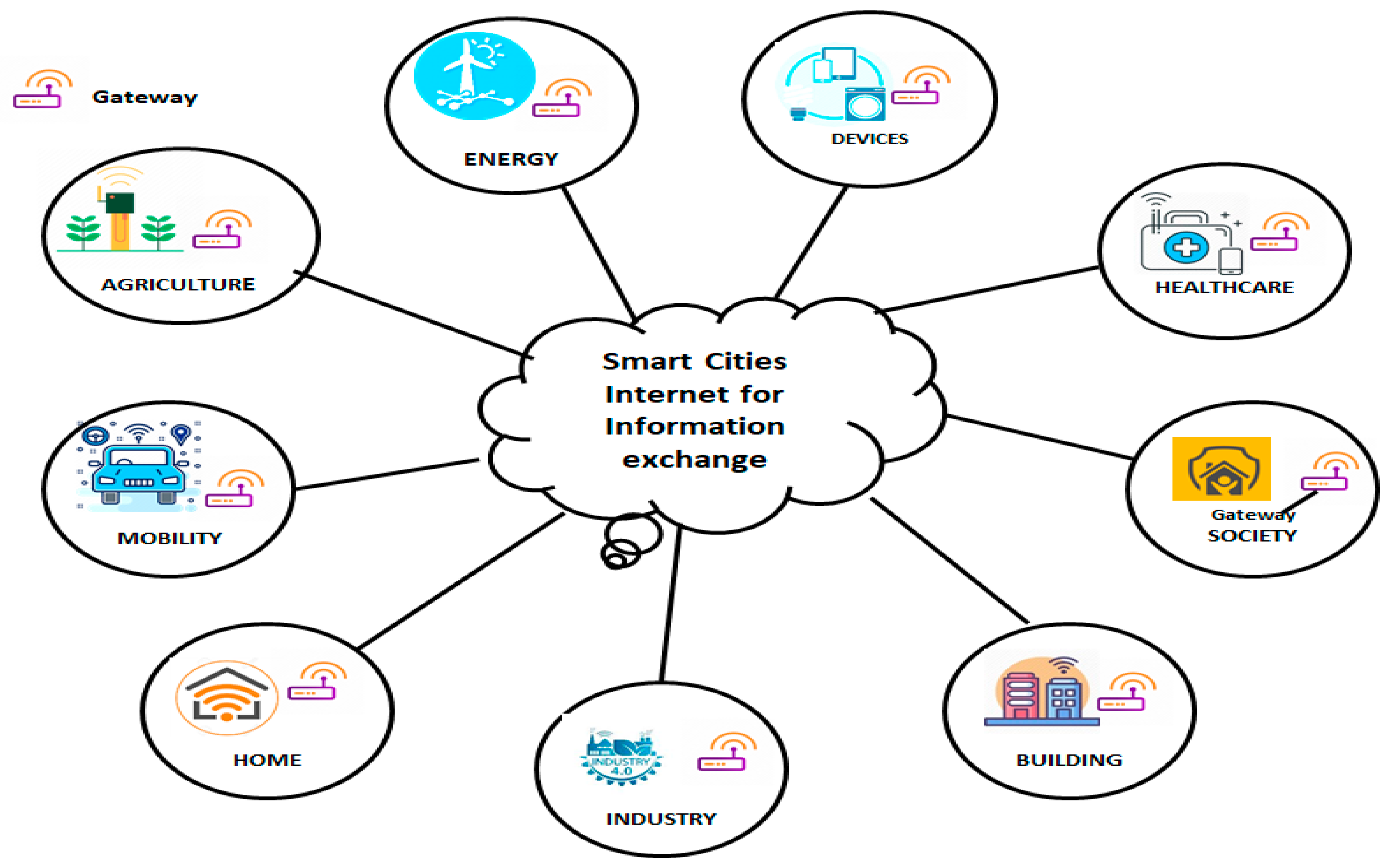

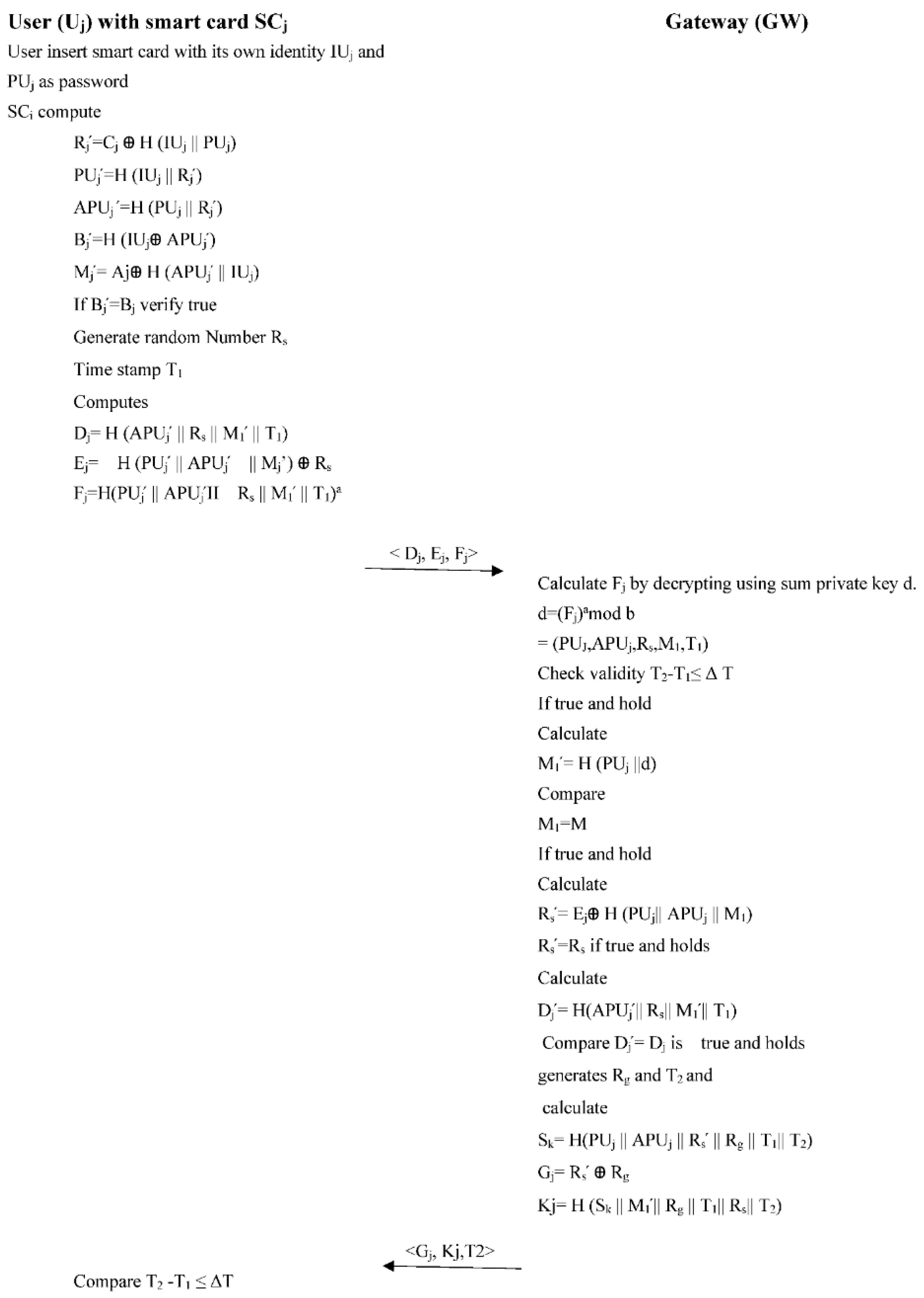
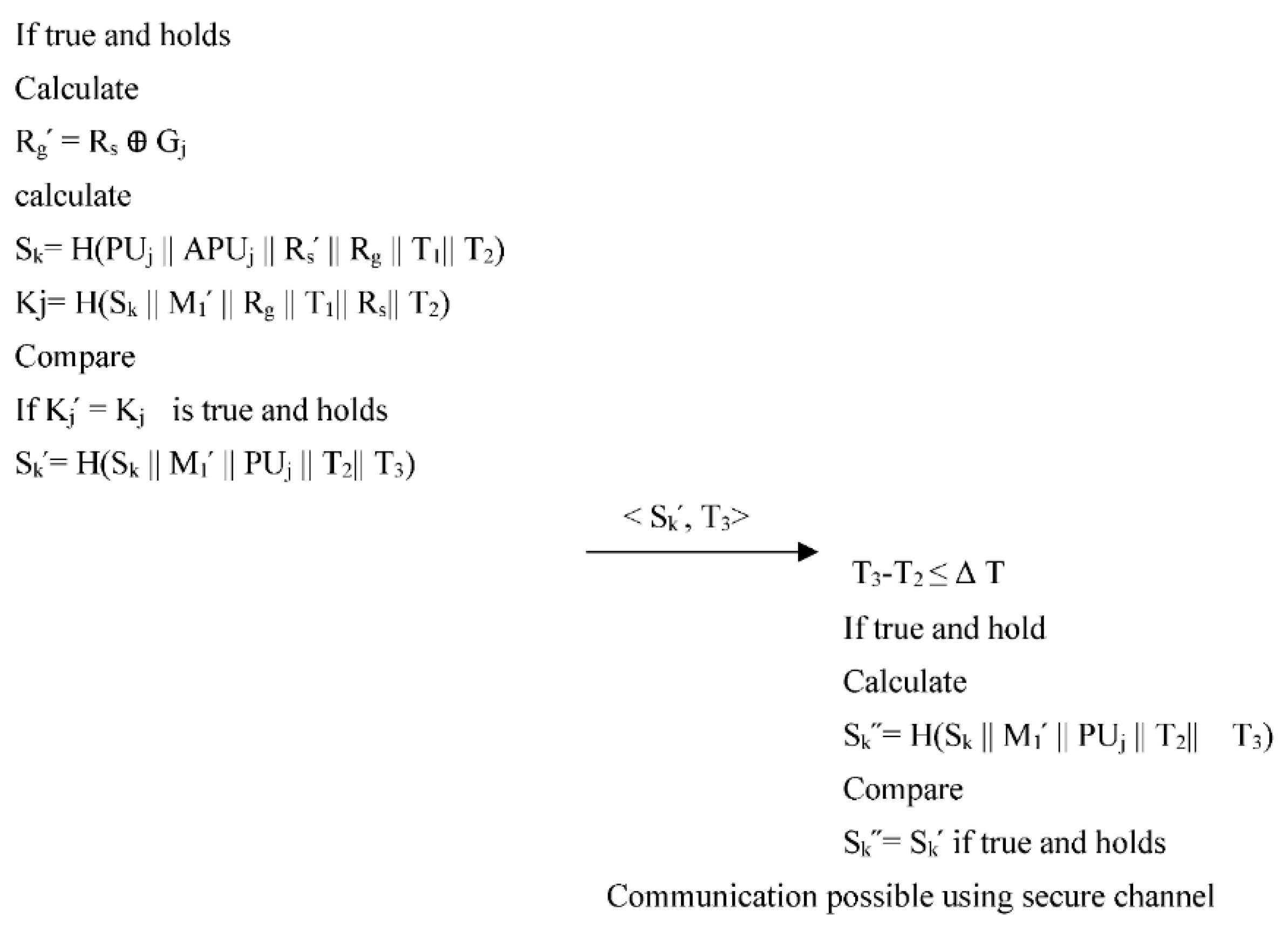
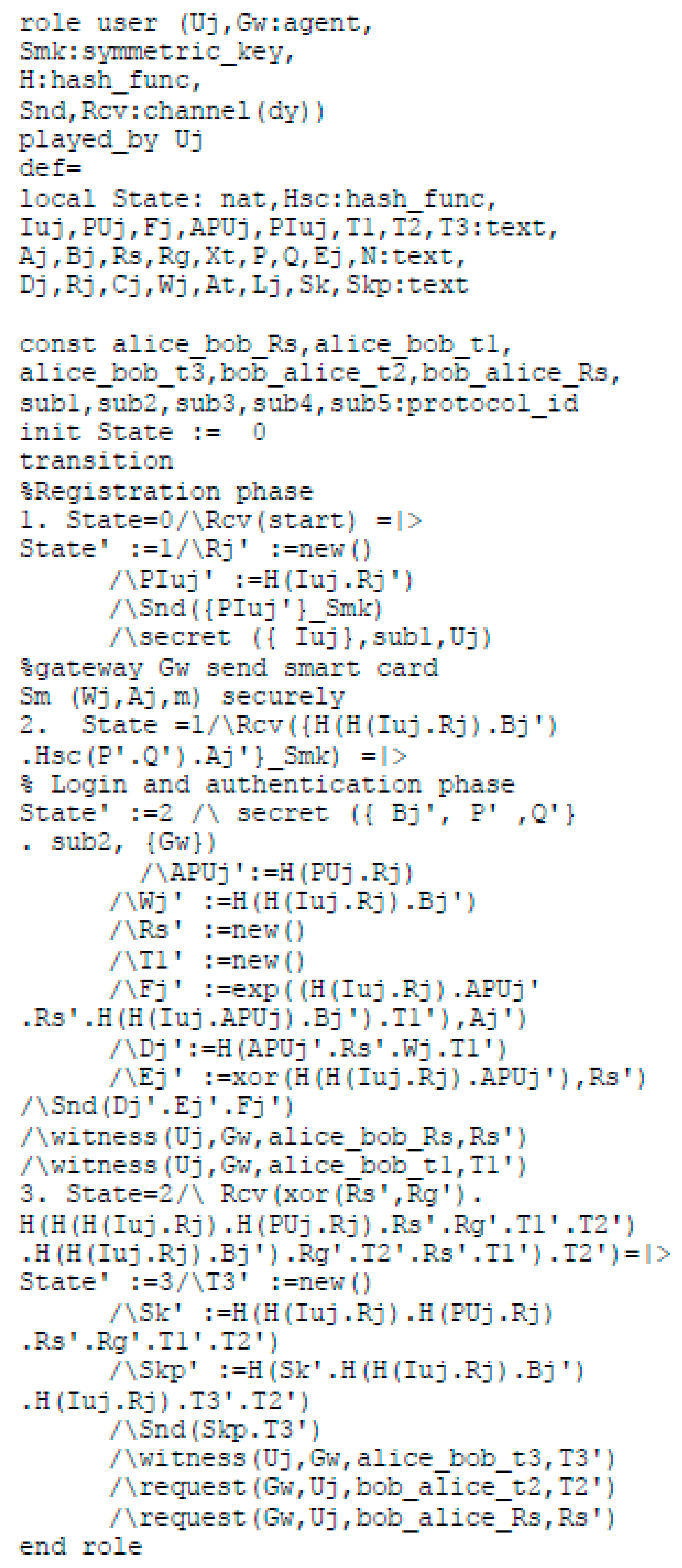


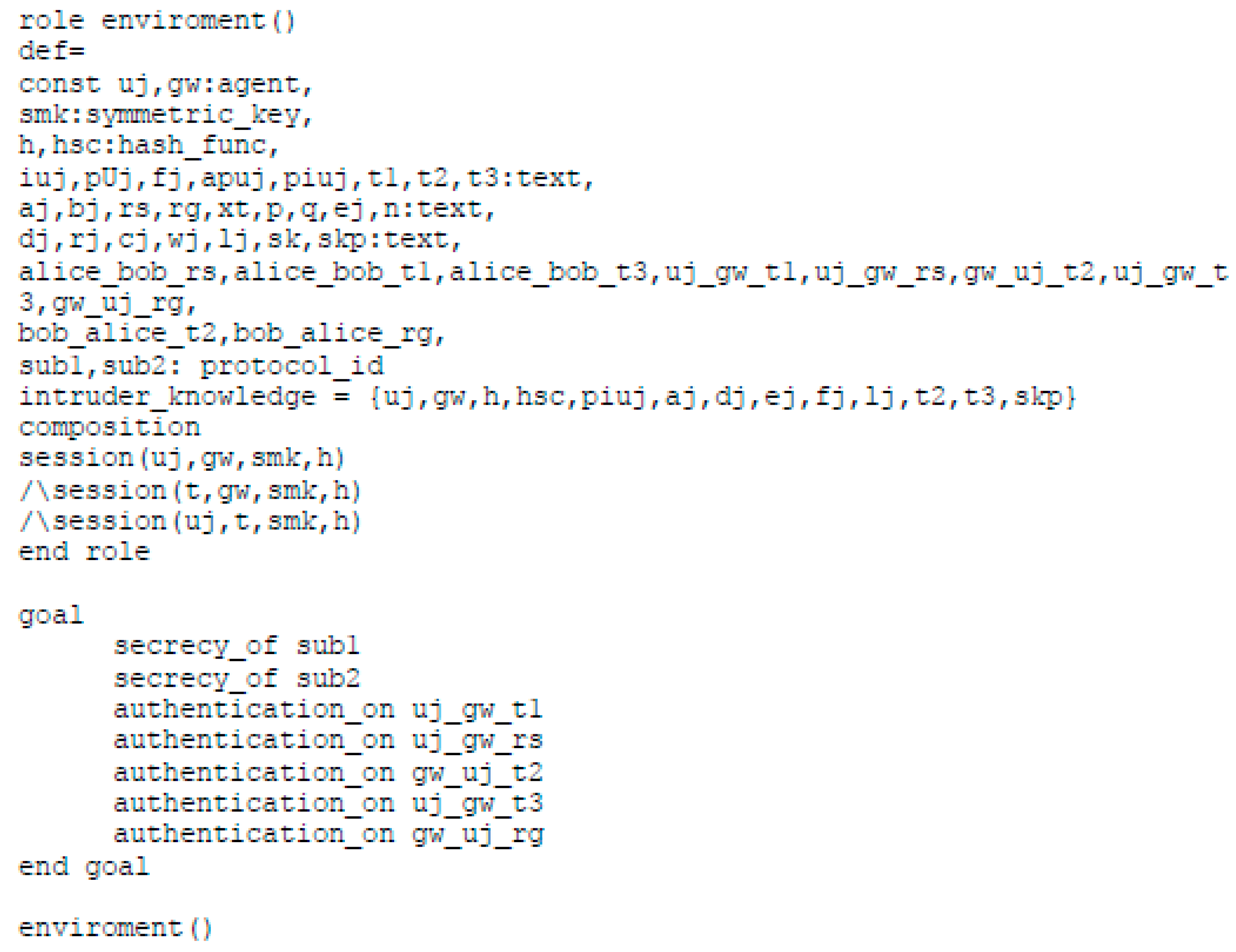

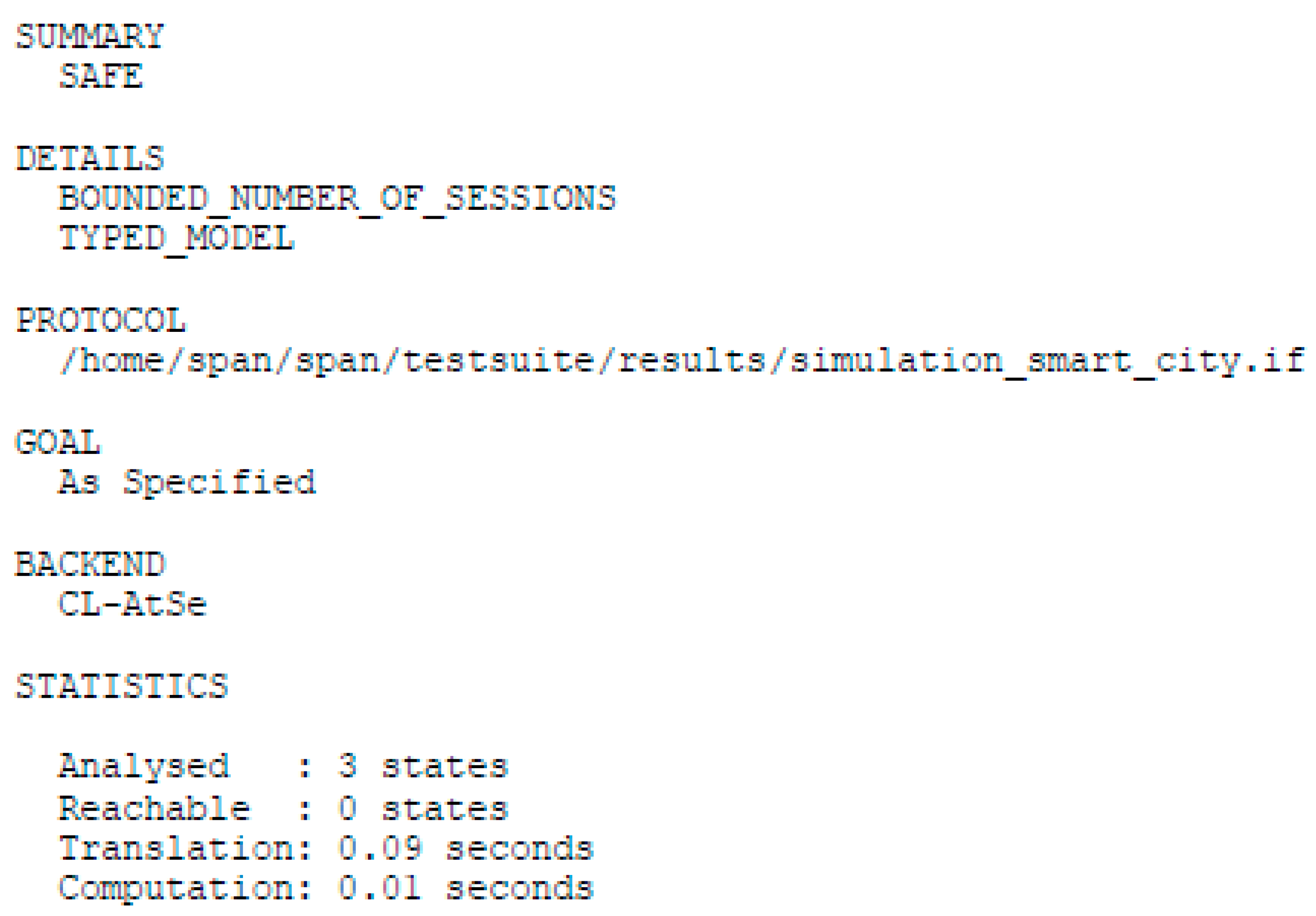
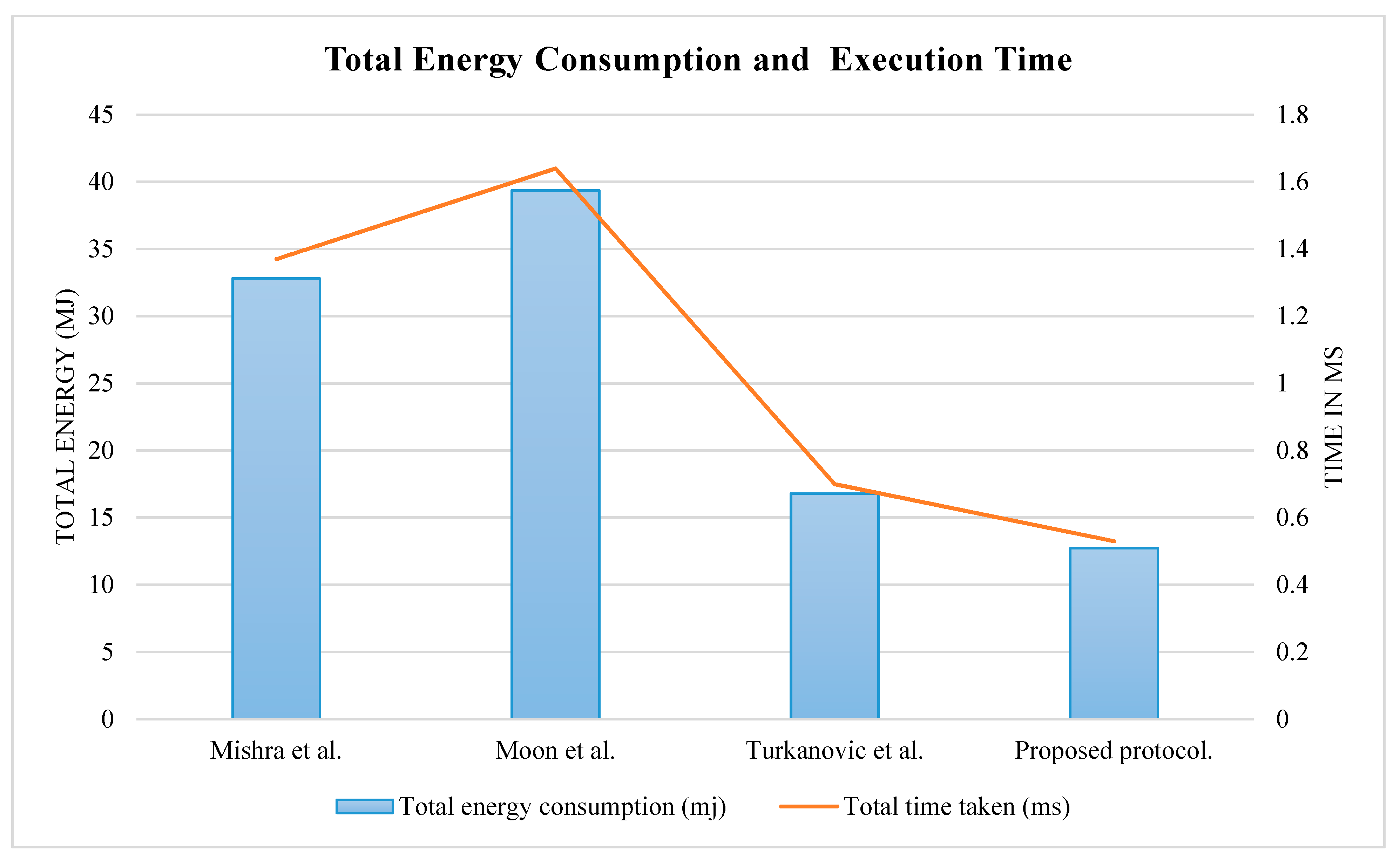
| References | Communication Cost | Computational Cost | Challenges of the Approach, Attacks Possible |
|---|---|---|---|
| [17] | 4 messages | 23TH + 8TE | Denial of service attack, privilege attack, ansider attack, untraceability, session key security, no mutual authentication |
| [18] | 3 Messages | 19TH + 3TM | Privilege attack, password guessing attack, untraceability, spoofing attack, no mutual authentication |
| [19] | 4 Messages | 17TH + 2TE + 6TM | Impersonation attack, anonymity, gateway spoofing attack, sensor spoofing attack, no mutual authentication |
| [20] | 5 Messages | 16TH + 4TE + 6TM | Password guessing attack, impersonation attack, no mutual authentication |
| [21] | 4 messages | 12TH + 4TE + 5TM | Anonymity, impersonation attack, denial-of-service attack, no mutual authentication |
| [22] | 3 Messages | 26TH + 2TE + 2TM | Password guessing attack, anonymity, no mutual authentication |
| [23] | 5 messages | 17TH + 4TE + 7TM | Denial of service attack, no mutual authentication |
| [24] | 4 Messages | 20TH + 6TE + 4TM | Impersonation attack, untraceability, no mutual authentication |
| [25] | 4 messages | 10TH + 7TE + 11TM | Anonymity, impersonation attack, no mutual authentication |
| Symbol | Description |
|---|---|
| Uj | User |
| GW | Gateway |
| d | Private key of gateway |
| ISi | Identity of the sensor |
| PKs | Public key of sensor |
| di | Private key of sensor |
| IUj | Identity of user |
| PUj | Password of the user |
| H( ) | One-way hash function |
| SCj | Smart card |
| a,b | Prime numbers |
| ΔT | Transmission delay |
| T1, T2, T3 | Time stamp |
| ⊕ | XOR operation |
| || | Concatenation |
| S.No | Security Feature | Mishra et al. [18] | Moon et al. [19] | Turkanovic et al. [17] | Proposed |
|---|---|---|---|---|---|
| 1 | Impersonation attack | Yes | No | Yes | Yes |
| 2 | Denial of service attack | Yes | Yes | No | Yes |
| 3 | Privilege attack | No | Yes | No | Yes |
| 4 | Insider attack | Yes | Yes | No | Yes |
| 5 | Smart card stolen | Yes | Yes | Yes | Yes |
| 6 | Offline password guessing attack | No | Yes | No | Yes |
| 7 | Man in the middle attack | Yes | Yes | Yes | Yes |
| 8 | Anonymity | Yes | No | Yes | Yes |
| 9 | Untraceability | No | Yes | No | Yes |
| 10 | Session key security | Yes | Yes | No | Yes |
| 11 | Forgery attack | Yes | Yes | Yes | Yes |
| 12 | Mutual authentication | Yes | Yes | No | Yes |
| 13 | Smart card revocation | Yes | Yes | No | Yes |
| 14 | Forward secrecy | Yes | Yes | Yes | Yes |
| 15 | Authentication of smart card | Yes | Yes | Yes | Yes |
| 16 | Gateway spoofing attack | No | No | No | Yes |
| 17 | Online password guessing attack | No | Yes | No | Yes |
| 18 | Malicious user attack | No | Yes | No | Yes |
| 19 | Sensor spoofing attack | No | No | No | Yes |
| 20 | Hidden gateway attack | No | No | No | Yes |
| Protocol | Registration Phase | Login Phase | Authentication Phase | Password Change Phase |
|---|---|---|---|---|
| Mishra et al. [25] | 3TH | TE + 3 TH | 3TE + 6 TH | 4TE + 11TH |
| Moon et al. [36] | 5TH | 2TM + 4 TH | 4TM + 2TE + 5TH | 3TH |
| Turkanovic et al. [24] | 7TH | 5TH + TM | 7TH + 2TM | - |
| Proposed | 3TH | TE + 4TH | 2TE + 5TH | 2TH |
| Protocol Phase | Mishra et al. [25] | Moon et al. [36] | Turkanovic et al. [24] | Proposed Protocol |
|---|---|---|---|---|
| Total cost | 23TH + 8TE | 17TH +2TE+ 6TM | 19TH +3TM | 14TH + 3TE |
| Total time taken | 1.37 ms | 1.64 ms | 0.70 ms | 0.53 ms |
| Total energy consumption | 32.8 mj | 39.36 mj | 16.8 mj | 12.72 mj |
Disclaimer/Publisher’s Note: The statements, opinions and data contained in all publications are solely those of the individual author(s) and contributor(s) and not of MDPI and/or the editor(s). MDPI and/or the editor(s) disclaim responsibility for any injury to people or property resulting from any ideas, methods, instructions or products referred to in the content. |
© 2023 by the authors. Licensee MDPI, Basel, Switzerland. This article is an open access article distributed under the terms and conditions of the Creative Commons Attribution (CC BY) license (https://creativecommons.org/licenses/by/4.0/).
Share and Cite
Gupta, S.; Alharbi, F.; Alshahrani, R.; Kumar Arya, P.; Vyas, S.; Elkamchouchi, D.H.; Soufiene, B.O. Secure and Lightweight Authentication Protocol for Privacy Preserving Communications in Smart City Applications. Sustainability 2023, 15, 5346. https://doi.org/10.3390/su15065346
Gupta S, Alharbi F, Alshahrani R, Kumar Arya P, Vyas S, Elkamchouchi DH, Soufiene BO. Secure and Lightweight Authentication Protocol for Privacy Preserving Communications in Smart City Applications. Sustainability. 2023; 15(6):5346. https://doi.org/10.3390/su15065346
Chicago/Turabian StyleGupta, Sunil, Fares Alharbi, Reem Alshahrani, Pradeep Kumar Arya, Sonali Vyas, Dalia H. Elkamchouchi, and Ben Othman Soufiene. 2023. "Secure and Lightweight Authentication Protocol for Privacy Preserving Communications in Smart City Applications" Sustainability 15, no. 6: 5346. https://doi.org/10.3390/su15065346
APA StyleGupta, S., Alharbi, F., Alshahrani, R., Kumar Arya, P., Vyas, S., Elkamchouchi, D. H., & Soufiene, B. O. (2023). Secure and Lightweight Authentication Protocol for Privacy Preserving Communications in Smart City Applications. Sustainability, 15(6), 5346. https://doi.org/10.3390/su15065346









